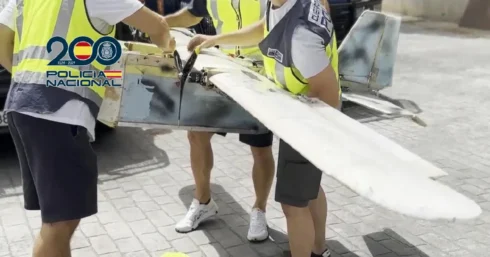SPAIN’S war on Class-A drug smuggling has taken a high-tech leap.
Traffickers, never short of cunning, have embraced drones, narco-submarines, and hidden tunnels, pushing law enforcement to the limits of innovation in their fight to keep narcotics off the streets.
This includes a sophisticated drone network recently dismantled in Algeciras, with custom-made UAVs ferrying up to 10 kilograms of hashish at a time from Morocco.
These weren’t your average hobby drones: built in Ukraine with a 50-kilometre range, they slipped silently across borders until police swooped in and seized the operation, arresting 10 suspects. But the sky is just one part of the puzzle.

Down at busy Valencia port, police have intercepted staggering shipments of cocaine this year concealed in the most industrial of disguises.
This includes 334 kilograms hidden inside industrial equipment on container ships, and a 304-kilo stash lurking inside a shipment of pineapples from Panama.
Clearly, traffickers know that fruit and freight are as much a delivery route as any yacht hull or suitcase.
Speaking of stealth, narco-submarines have resurfaced as a particularly slippery menace.
Authorities intercepted a semi-submersible vessel carrying a whopping 6.6 tonnes of cocaine in the Atlantic en route to Spain, last month.
These underwater ghost ships evade radar, surfacing as shadows in the waves and reminding law enforcement that the drug trade’s ingenuity knows no bounds.
On the personal smuggling front, a man was caught with cocaine cleverly hidden beneath a wig on a flight from Colombia to Amsterdam.
Nearly 20 tiny capsules of the white powder concealed within synthetic hair proved that when it comes to smuggling, traffickers will exploit every possible hiding place.
Even the borders themselves can no longer be trusted. In the Spanish enclave of Ceuta, a secret tunnel was unearthed, stretching 50 metres underground from a warehouse in Spain straight into Morocco.
This subterranean passage exemplifies the shadowy lengths drug rings will go to avoid detection.
To counter these evolving threats, Spanish police and customs have stepped up with a combination of cutting-edge technology and tactical innovation.
High-resolution drones and radar systems now patrol the coastline, scanning for unauthorised drone flights and unusual maritime activity.
At ports, sophisticated X-ray scanners and AI-driven cargo inspections help identify anomalies in freight shipments, while sniffer dogs trained to detect narcotics continue to play an indispensable role.
READ MORE:
- Pictured: Narco drones used by ex-military gang to fly drugs from Morocco to southern Spain
- ‘Narcosubs’: The new silent menace smuggling hundreds of tonnes of drugs into Spain along the now-infamous ‘cocaine superhighway’
On land and air, joint task forces composed of Guardia Civil, National Police, and customs officials coordinate real-time intelligence sharing while rapid response units are sent out to intercept smugglers before their cargo gets landed.
Specially trained K9 units are deployed not only at airports but also at less obvious checkpoints, including highways and warehouses.
Additionally, Spanish authorities collaborate closely with their counterparts in Morocco and other EU countries, exchanging intelligence and conducting joint operations to dismantle trafficking networks at their roots.
Public awareness campaigns and community reporting hotlines also bolster the frontline, encouraging citizens to report suspicious activities.
In this relentless game of cat and mouse, Spanish authorities have had to evolve rapidly. International cooperation, advanced technology, and dogged determination have become the backbone of their strategy to shut down increasingly brazen and inventive smuggling operations.
The stakes remain high, but the message is clear: no matter how ingenious the methods, Spain’s fight against Class A drugs is far from over – and the hunters aren’t backing down.
Click here to read more Crime News from The Olive Press.








